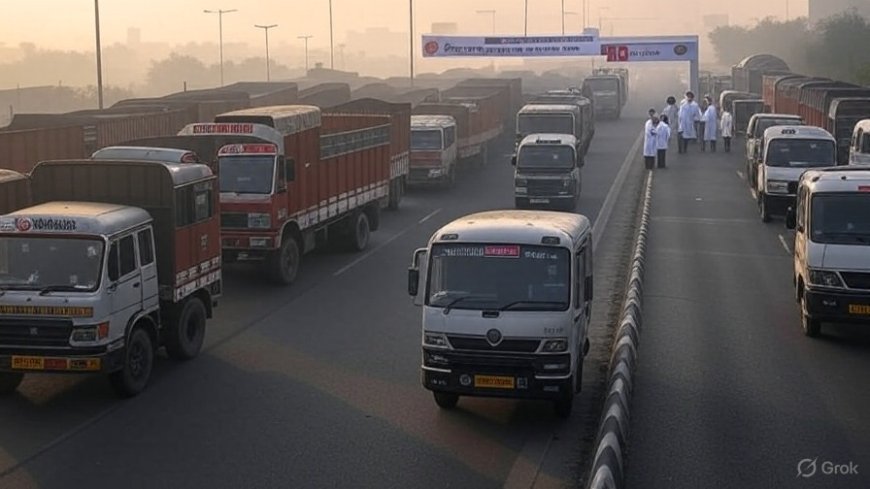Delhi Unveils ₹50-Lakh Innovation Challenge to Retrofit BS-IV Trucks, Engages Students in Clean-Tech Ideathon
Delhi government launches ₹50-lakh innovation challenge to retrofit BS-IV trucks with BS-VI tech and hosts industrial ideathon engaging students in clean-tech innovation.

In a bold step to combat the capital’s perennial air pollution crisis, the Delhi government has launched a ₹50-lakh Innovation Challenge aimed at retrofitting BS-IV diesel trucks to meet BS-VI emission standards. The move, announced by Delhi Environment Minister Gopal Rai, seeks to identify and support low-cost, scalable retrofitting technologies, while encouraging students, startups, and innovators to participate through an Industrial Ideathon.
The initiative—a first-of-its-kind public-private technology hunt in India—aims to bring new energy to the clean vehicle transformation space, especially in the commercial transport segment that continues to be a major source of PM2.5 emissions in the NCR.
Bridging Policy and Innovation: The Core of the Challenge
With India’s shift from BS-IV to BS-VI emission norms now fully implemented in new vehicles since April 2020, the challenge remains in upgrading the legacy fleet, especially heavy-duty diesel trucks that still ply in and around Delhi. These vehicles are not just polluters; they represent low-margin livelihoods, making costly replacement unfeasible.
Through the ₹50-lakh innovation grant, the Delhi government aims to stimulate practical R&D solutions that offer:
-
Low-cost retrofitting kits
-
BS-VI-level emission control technology
-
Fuel conversion methods (e.g., diesel to CNG/LNG)
-
Scalable solutions suitable for small fleet operators
Minister Gopal Rai emphasized the government’s intent:
“This challenge is not just about compliance; it’s about sustainable transformation. We want to empower innovators to make clean trucking accessible.”
How the Challenge Works: Incentives and Selection
The innovation challenge will unfold in three phases:
-
Application Phase: Open to students, researchers, startups, engineering firms, and clean-tech entrepreneurs. Applicants must present a concept note and technical feasibility.
-
Prototype Phase: Selected entries will receive grant support of up to ₹10 lakh each to develop functional prototypes.
-
Pilot Deployment: The top 2–3 solutions will be deployed on live vehicle trials with logistical partners in Delhi. Winners may receive commercialization support and policy endorsement.
Finalists will also be invited to showcase at the Delhi Environment Innovation Expo 2026, expected to draw major industry players and policymakers.
Industrial Ideathon: Tapping Student Talent for a Cleaner Capital
Parallel to the innovation challenge, Delhi is launching an Industrial Ideathon in collaboration with DTU (Delhi Technological University), NSUT, and select IITs. This engagement aims to integrate fresh academic insights and youth-driven ideas into real-world emissions technology.
Students will participate in:
-
Clean mobility hackathons
-
Vehicle emissions modeling challenges
-
Design-a-sensor contests
-
Simulation labs supported by Delhi Pollution Control Committee (DPCC)
Winners will receive internship opportunities, monetary prizes, and mentoring from automotive industry experts. Many educational leaders view this as a practical convergence of green education and governance.
Air Pollution in Delhi: The Numbers Behind the Push
According to recent data from the Centre for Science and Environment (CSE), nearly 30% of Delhi’s vehicular emissions come from outdated diesel trucks. These vehicles, especially those with BS-III and BS-IV engines, emit significantly higher levels of nitrogen oxides (NOx) and particulate matter (PM) compared to BS-VI-compliant models.
Air quality data from 2024 showed that Delhi experienced over 150 days of unhealthy air, with PM2.5 levels regularly breaching safe limits. Despite improvements in monitoring and enforcement, legacy emissions remain a persistent challenge.
In this context, the new innovation challenge could become a transformative step, if it enables an affordable path to emission compliance for existing fleet owners.
For a deeper dive into vehicular pollution data, you can refer to this comprehensive study by TERI on air quality trends in Delhi.
Industry and Civic Response: Cautious Optimism
Truckers' associations and vehicle retrofitters have welcomed the announcement with measured optimism. While many remain skeptical about retrofitting costs, the possibility of government-backed solutions has sparked interest.
Rajinder Singh, president of the Delhi Goods Transporters Association, stated:
“If a working, low-cost retrofitting kit comes through this challenge, it could help thousands of small operators avoid a complete vehicle replacement.”
Auto component manufacturers and emission control device makers are also eyeing this challenge as a platform for innovation and collaboration. Companies like Bosch, Greaves Cotton, and Altigreen have reportedly shown interest in mentoring participants or co-developing prototypes.
Looking Ahead: Policy Implications and National Scalability
If the Delhi retrofitting challenge proves successful, it may serve as a template for national replication, especially in other urban pollution hotspots like Mumbai, Kolkata, and Bengaluru.
The initiative also aligns with India’s broader environmental and economic goals, including:
-
Reducing import dependency on fossil fuels
-
Promoting Make-in-India innovation
-
Supporting the National Electric Mobility Mission (NEMM)
-
Ensuring a just transition for low-income workers
For a policy lens on clean mobility transitions, explore this insightful report by NITI Aayog on India's emission strategies.
Challenges Ahead: Funding, Scale, and Implementation
Despite its potential, the challenge is not without risks. Experts caution that:
-
Technology validation will be critical to ensure safety and efficiency of retrofitted vehicles.
-
On-road testing and ARAI approvals could delay deployment.
-
Public buy-in depends on pricing and long-term cost savings.
To overcome these hurdles, the Delhi government is also considering tax incentives, loan subsidies, and fast-track homologation clearances for winning technologies—should they prove commercially viable.
Conclusion: Innovation Meets Urgency
Delhi’s ₹50-lakh innovation challenge isn’t just about emissions—it's a bet on Indian ingenuity, youth participation, and climate urgency converging to clean the capital’s air.
By placing faith in science, startups, and students, the city is offering a unique model of decentralized, incentive-driven problem-solving. As Delhi struggles with one of the world's most polluted airsheds, such initiatives may not only retrofit trucks but retrofit public trust in government-led innovation.
The coming months will reveal if the blueprint converts into impact—but the launch has already set the tone for a more collaborative and inclusive approach to environmental governance.



















































